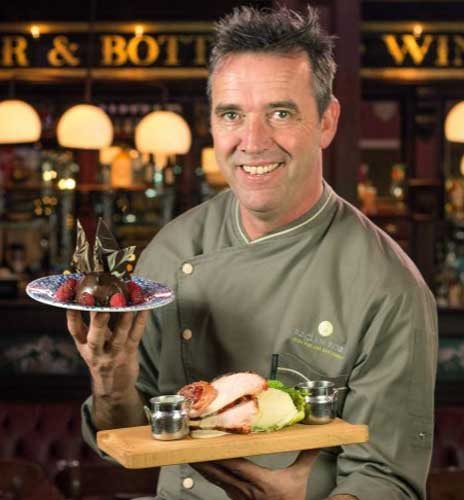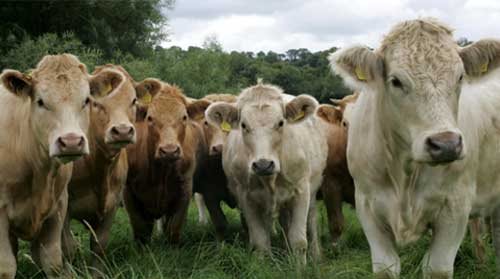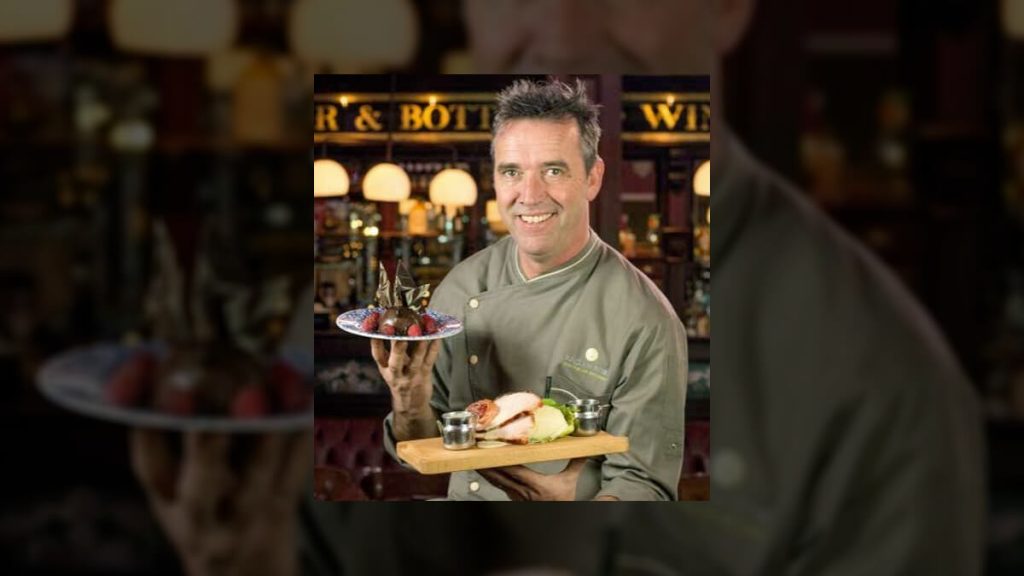Let’s at least start on a positive note: Celebrated chef, author & TV personality Kevin Dundon – the man that Tourism Ireland has repeatedly chosen as the Face of Irish Food – loves a lot of what happens in the United States on March 17th.
“I mean, look at what they do in Chicago on Saint Patrick’s Day. They toss all of this vegetable-based dye into the Chicago River and then paint it green for a day. That’s terrific,” Kevin said.
But then when it comes to what many Americans eat & drink on St. Paddy’s Day (i.e., a big plate of corned beef and cabbage. Which is then washed down with a mug of green beer) … Well, that’s where Dundon has to draw the line.

“Green beer? No real Irishman would be caught dead drinking that stuff,” Kevin insists. “And as for eating corned beef & cabbage … That’s not actually authentic Irish fare either. Bacon and cabbage? Sure. But corned beef & cabbage was something that the Irish only began eating after they’d come to the States to escape the Famine. And even then these Irish-Americans only began serving corned beef & cabbage to their friends & family because they had to make do with the ingredients that were available to them at that time.”
And thus begins the strange tale of how corned beef & cabbage came to be associated with the North American celebration of Saint Patrick’s Day celebration. Because – according to Dundon – beef just wasn’t all that big a part of the Irish diet back in the 19th century.
To explain: Back in the Old Country, cattle – while they were obviously highly prized for the milk & cheese that they produced – were also beasts of burden. Meaning that they were often used for ploughing the fields or for hauling heavy loads. Which is why – back then — these animals were rarely slaughtered when they were still young & healthy. If anything, land owners liked to put a herd of cattle on display out in one of their pastures because that was then a sign to their neighbors that this farm was prosperous.

“Whereas pork … Well, everybody raised pigs back then. Which is why pork was a staple of the Irish diet rather than beef,” Dundon continued.
So if that’s what people actually ate back in the Old Country, how then did corned beef & cabbage come to be so strongly associated with Saint Patrick’s Day in the States.? That largely had to do with where the Irish wound up living after they arrived in the New World.
“When the Irish first arrived in America following the Great Famine, a lot of them wound up living in the inner city right alongside the Germans & the Jews, who were also recent immigrants to the States. And while that farm-fresh pork that the Irish loved wasn’t readily available, there was brisket. Which the Irish could then cure by first covering this piece of meat with corn kernel-sized pieces of rock salt – that’s how it came to be called corned beef. Because of the sizes of the pieces of rock salt that were used in the curing process – and then placing all that in a pot of water with other spices to soak for a few days.”
And as for the cabbage portion of corned beef & cabbage … Well, according to Kevin, in addition to buying their meat from the kosher delis in their neighborhood, the Irish would also frequent the stores that the German community shopped in. Where – thanks to their love of sauerkraut (i.e., pickled cabbage) – there was always a ready supply of cabbage to be had.
“So when you get right down to it, it was the American melting pot that led to corned beef & cabbage being found in the Irish-American cooking pot,” Dundon continued. “Since they couldn’t find or didn’t have easy access to the exact same ingredients that they had back in Ireland, Irish-Americans made do with what they could find in the immediate vicinity. And what they made was admittedly tasty. But it’s not actually authentic Irish fare.”
Mind you, what Kevin serves at Raglan Road Irish Pub and Restaurant at Disney Springs (which – FYI – Orlando Magazine voted as the area’s best restaurant back in 2014) is nothing if not authentic. Dundon and his team at this acclaimed gastropub pride themselves on making traditional Irish fare and then contemporized it.
“Take – for example – what we serve here instead of corned beef & cabbage. Again, because it was pork – rather than beef – that was the true staple of the Irish diet back then, what we offer instead is a loin of bacon that has been glazed with Irish Mist. That then comes with colcannon potatoes. Which is this traditional Irish dish that’s made up of mashed potato that have had some cabbage & bacon mixed through it,” Kevin enthused. “This heavenly ham – that’s what we actually call this traditional Irish dish at Raglan Road, Kevin’s Heavenly Ham – also includes some savory cabbage with a parsley cream sauce as well as a raisin cider jus. It’s simple food. But because of the basic ingredients – and that’s the real secret of Irish cuisine. That our ingredients are so strong – the flavors just pop off the plate.”
Which brings us to the real challenge that Dundon and the Raglan Road team face every day. Making sure that they actually have all of the ingredients necessary to make this traditional-yet-contemporized Irish fare to those folks who frequent this Walt Disney World favorite.
“Take – for example – the fish we serve here. We only used cold water fish. Salmon, mussels and haddock that have been hauled out of the Atlantic, the ocean that America and Ireland share,” Kevin stated. “Not that there’s anything wrong with warm water fish. It’s just that … Well, it doesn’t have the same structure. It’s a softer fish, which doesn’t really fit the parameters of Irish cuisine. And if you’re going to serve authentic food, you have to be this dedicated when it comes to sourcing your ingredients.
And if you’re thinking of perhaps trying to serve an authentic Irish meal this year, rather than once again serving corned beef & cabbage at your Saint Patrick’s Day Feast … Well, back in September of last year, Mitchell Beazley published “The Raglan Road Cookbook: Inside America’s Favorite Irish Pub.” This 296-page hardcover not only includes the recipe for Kevin’s Heavenly Ham but also it tells the tale of how this now-world-renown restaurant wound up being built in Orlando.
On the other hand, if you happen to have to the luck of the Irish and are actually down at The Walt Disney World Resort right now, it’s worth noting that Raglan Road is right in the middle of its Mighty St. Patrick’s Day Festival. This four day-long event – which includes Irish bands and professional dancers – stretches through Sunday night. And in addition to all that authentic Irish fare that Dundon and his team are cooking up, you also sample the fine selection of beers & cocktails that this establishment’s four distinct antique bars (each of which are more than 130 years old and were imported directly from Ireland) will be serving. Just – As ucht Dé (That’s “For God’s Sake” in Gaelic) – don’t make the mistake of asking the bartender there for a mug of green beer.
“Why would anyone willingly drink something like that?,” Dundon laughed. “I mean, just imagine what their washroom will look like the morning after.”
This article was originally published by the Huffington Post on Friday, March 17, 2017
